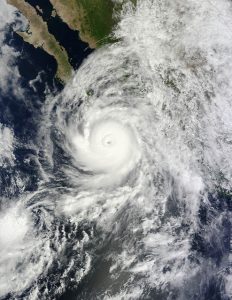
Originally Posted October 19, 2016.
The rain and wind of Hurricane Matthew may have stopped, but much of North Carolina is still under water. The hard work of repairing and rebuilding has begun across the southeastern U.S. and the Caribbean, particularly in Haiti where they are still reeling from the 2010 earthquake. Hurricanes – so called natural disasters – are not simply the result of the weather but become “disasters” because of how society shapes people’s risks and how people prepare, adapt, and respond.
Extreme weather events like hurricanes often become problems because of the ways society has changed the environment, such as locating cities in areas at risk of flooding, filling in wetlands for development, and building homes on eroding coastlines. Government policies are also major factors in where, why, and when an event becomes a human disaster because development policies have contributed to creating risky areas while response plans are often inadequate.
- David L. Brunsma, David Overfelt, and Steven J. Picou. 2007. The Sociology of Katrina: Perspectives on a Modern Catastrophe. Lanham, MD: Rowman & Littlefield Publishers.
- Raymond J. Burby. 2006. “Hurricane Katrina and the Paradoxes of Government Disaster Policy: Bringing about Wise Governmental Decisions for Hazardous Areas.” The Annals of the American Academy of Political and Social Science 604:171–91.
- Susan L. Cutter, Bryan J. Boruff, and W. Lynn Shirley. 2003. “Social Vulnerability to Environmental Hazards.” Social Science Quarterly 84(2):242–61.
The risks and burdens of disasters are not evenly distributed. Communities with the least economic, social, and political power often face the greatest threats from natural disasters and are also the least able to prepare, evacuate and rebuild. Socio-economic status affects where people live and the quality of their housing. Poor and working class communities also tend to bear greater physical, emotional, and psychological impacts of displacement and have fewer resources and government support to rebuild and recover after a catastrophe.
- Piers M. Blaikie. 1994. At Risk: Natural Hazards, People’s Vulnerability, and Disasters. London; New York: Routledge.
- Alice Fothergill and Lori A. Peek. 2004. “Poverty and Disasters in the United States: A Review of Recent Sociological Findings.” Natural Hazards 32(1):89–110.
- Walter Gillis Peacock, Betty Hearn Morrow, and Hugh Gladwin. 1997. Hurricane Andrew: Ethnicity, Gender, and the Sociology of Disasters. London ; New York: Routledge.
Economic inequality and race also contribute to different levels of vulnerability and resiliency between countries around the globe. Communities of color are more likely to be threatened by environmental disasters and be less prepared, while government evacuation and reconstruction programs tend be limited for these communities. Researchers who studied Hurricane Katrina point to how experiences of the storm were shaped by institutional racism and how the effects exacerbated racial and class inequalities. For example, government aid was slower to reach African American communities who also spent more time in shoddy temporary housing and had more trouble rebuilding their neighborhoods.
- Robert D. Bullard and Beverly Wright. 2009. Race, Place, and Environmental Justice after Hurricane Katrina: Struggles to Reclaim, Rebuild, and Revitalize New Orleans and the Gulf Coast. Boulder, Colo.: Westview Press.
- Kristin Ann Bates and Richelle S. Swan. 2007. Through the Eye of Katrina: Social Justice in the United States. Durham, NC: Carolina Academic Press.
Women and children also bear a greater burden and risk from disasters because they tend to have fewer resources. Women typically have more responsibilities of caring for children and aging relatives, yet they have also been leaders in the recovery process after countless disasters, organizing their communities to rebuild and demanding a government response. Natural disasters have a large impact on children due to the trauma, displacement, and disruption of their lives. Research found that childrens’ ability to respond and adapt after Katrina was related to their family’s race and class, with more vulnerable children experiencing greater detrimental effects on their well-being after the storm.
- Emmanuel David and Elaine Pitt Enarson. 2012. The Women of Katrina: How Gender, Race, and Class Matter in an American Disaster. Nashville, TN: Vanderbilt University Press.
- Elaine Pitt Enarson and Betty Hearn Morrow. 1998. The Gendered Terrain of Disaster: Through Women’s Eyes. Westport, CT: Praeger.
- Alice Fothergill and Lori A. Peek. 2015. Children of Katrina. Austin, TX: University of Texas Press.

Comments